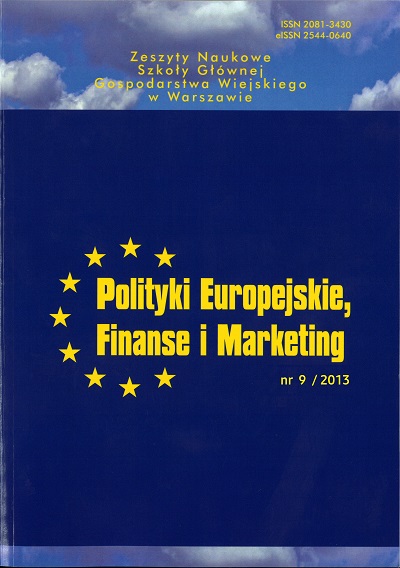Main Article Content
Article Details
Akaike, H. (1974), A New Look at the Statistical Model Identification, I.E.E.E. Transactions on Automatic Control, 19, 716-723. (Crossref)
Arteta C., B. Eichengreen, C. Wyplosz, On the Growth Effects of Capital Account Liberalization, manuscript, University of California, Berkeley CA, 2001.
Aziz, J., Caramazza, F., i R. Salgado (2000) Currency Crises: In Search of Common Elements, IMF Working Paper 00/67. (Crossref)
Baccheta M., M. Jansen, C. Lennon i R. Piermartini, Exposure to external shocks and the geographical diversification of exports (w:) Newfarmer, R., Shaw, W., P. Walkenhorst, Breaking into New Markets: Emerging Lessons for Export Diversification. Washington DC, World Bank 2009.
Barro, R. J. (2001) Economic Growth in East Asia Before and After the Financial Crisis, NBER Working Paper 8330. (Crossref)
Boyd J. H., Kwak S. i B. Smith (2005) The Real Output Losses Associated with Modern Banking Crises, Journal of Money, Credit, and Banking 37, 977-999. (Crossref)
Broda C., (2004) Terms of trade and exchange rate regimes in developing countries. Journal of International Economics 63[1], 31-58. (Crossref)
Brodzicki T., Otwartość a wzrost gospodarczy - wyniki dotychczasowych badań i wnioski na przyszłość, Analizy i Opracowania KEIE Uniwersytet Gdański nr 2/2006, Gdańsk 2006.
Calderon C., N. Loayza, K. Schmidt-Hebbel, Does Openness Imply Greater Exposure?, The World Bank, September 2005. (Crossref)
Dell'Ariccia G., Detragiache E. i R. Rajan 2005. The real effect of banking crises. IMF Working Paper 05/63. (Crossref)
Dollar D., Outward-Oriented Developing Economies Really Do Grow More Rapidly: Evidence from 95 LDCs, 1976-85, Economic Development and Cultural Change, 1992. (Crossref)
Domańska A., Rozprzestrzenianie się kryzysów gospodarczych: mechanizmy i uwarunkowania. Kryzys 2007-2009 w wybranych regionach świata, opracowanie w ramach badań statutowych.
KES, 2010. Domańska A., Otwartość gospodarki jako uwarunkowanie poziomu i wahań wzrostu gospodarczego. Kontrowersje wokół teorii i wyników badań empirycznych, badania własne KES SGH, Warszawa 2010.
Frydl, E.J. (1999) The length and cost of banking crises. IMF Working Paper 99/30. (Crossref)
Hoggarth, G., Reis, R. i V. Saporta (2002) Costs of banking system instability: some empirical evidence, Journal of Banking and Finance 26, 825-855. (Crossref)
Honohan P. i D. Klingebiel (2002) Controlling the Fiscal Costs of Banking Crises, w: Managing the Real and Fiscal Effects of Banking Crises, World Bank Discussion Paper No. 428. (Crossref)
Hutchinson, M. M. i H. Noy (2005) How Bad are the Twins? Output Costs of Currency and Banking Crises, Journal of Money, Credit and Banking 37, 725-752. (Crossref)
Kroszner, R. S., Laeven L. i D. Klingebiel (2007) Banking crises, financial dependence, and growth, Journal of Financial Economics 84 (2007) 187-228.
Easterly W., S. Rebelo, Fiscal Policy and Economic Growth: An Empirical Investigation, NBER Working Paper no. 4499, 1993. (Crossref)
Edison H.J., R. Levine, L. Ricci, T. Slok, International Financial Integration and Economic Growth, Journal of International Money and Finance 21, 2002. (Crossref)
Edwards S., Openness, productivity and growth: What do we really know? The Economic Journal, vol. 108, 1998. (Crossref)
Jansen M., C. Lennon i R. Piermartini, Exposure to External Country Specific Shocks and Income Volatility, World Trade Organization Staff Working Paper, January 2009. (Crossref)
Kose M.A., E.S. Prasad, M. Terrones, How do Trade and Financial Integration affect the Relationship between Growth and Volatility?, IMF Working Paper WP/05/19, January 2005. (Crossref)
di Giovanni J., A. A. Levchenko, Trade Openess and Volatility, IMF Working Paper 2008, WP/08/146. (Crossref)
Irwin D.A, M. Terviö, Does Trade raise Income? Evidence from the Twentieth Century, Journal of International Economics 58: 1-18, 2002. (Crossref)
Kose M. A., Explaining Business Cycles in Small Open Economies: How Much do World Prices Matter, Journal of International Economics, Vol. 56, 2002, No. 2 (March). (Crossref)
Kroszner, R. S., Laeven L. i D. Klingebiel (2007) Banking crises, financial dependence, and growth, Journal of Financial Economics 84 (2007) 187-228. (Crossref)
Levchenko A.A., L.T.Lewis, L.L.Tesar, The collapse of international trade during the 2008-2009 crisis: in search of the smoking gun, NBER Working paper 16006, May 2010. (Crossref)
Międzynarodowy Fundusz Walutowy (1998) Financial Crises and Indicators of Vulnerability, World Economic Outlook, Ch. 4, maj.
Międzynarodowy Fundusz Walutowy (1999) From Crisis to Recovery In the Emerging Market Economics, World Economic Outlook, Ch. 2, październik.
Schmitt-Grohé S., The International Transmission of Economic Fluctuations, Journal of International Economics 44, 1998. (Crossref)
Schwarz, G. (1978), Estimating the Dimension of a Model, Annals of Statistics, 6, 461-464. (Crossref)
World Economic Outlook 2008, Financial Stress, Downturns and Recoveries, International Monetary Fund, October 2008.
World Economic Outlook 2009, Crisis and Recovery, International Monetary Fund April 2009.
Raddatz, C. (2007) Are external shocks responsible for the instability of output in low-income countries? Journal of Development Economics 84[1], 155-187. (Crossref)
Razin A., Y. Rubinstein, Growth Effects of Exchange Rate Regimes and Capital Account Liberalization in the Presence of Crises: A Nuanced View, NBER Working Paper 10555, June 2004. (Crossref)
Rodrik D., Has Globalization Gone Too Far? Institute for International Economics Washington D.C., 1997. (Crossref)
Serwa, D. (2010) Larger crises cost more: Impact of banking sector instability on output growth, Journal of International Money and Finance 29, 1463-1481. (Crossref)
Downloads
- Sławomir Dybka, Produkty regionalne jako element aktywnej polityki asortymentowej ukierunkowanej na konsumenta , Zeszyty Naukowe SGGW, Polityki Europejskie, Finanse i Marketing: Nr 9(58) (2013)
Możesz również Rozpocznij zaawansowane wyszukiwanie podobieństw dla tego artykułu.

Utwór dostępny jest na licencji Creative Commons Uznanie autorstwa – Użycie niekomercyjne 4.0 Międzynarodowe.





